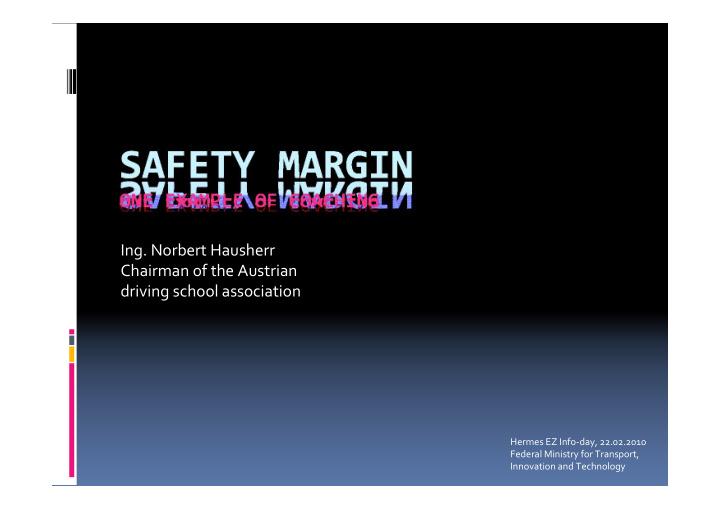



Ing. Norbert Hausherr Chairman of the Austrian driving school association Hermes EZ Info-day, 22.02.2010 Federal Ministry for Transport, Innovation and Technology
Overview � Reasons for cooperation � Examples of coaching scenarios � Examples of teaching � One detailed scenario – Safety Margin � Conclusion
Reasons for cooperation � The training for the driving licence consists of the theoretical and the practical part. The theoretical one should be the basis for understanding the traffic rules. � Only learning for passing the test is not enough, the knowledge must be used correctly in traffic situations. � Coaching should support understanding and make better connection between theoretical and practical training.
Examples of coaching scenarios � Who is a good driver ? � Have a reason for restriction of overtaking � Explaining the principle of trust � Discussion about the right traffic lane � What is „Driving at sight“? � Why should you not drive drunk? � What ist very dangerous on highways? � What should you do, if a car is driving on the wrong side of a highway? � What should you do in a road accident? � What is eco-driving? � How will you do an emergency braking? � How can you recognize that other people are inattentive? � What should you do if an ambulance come closer? � How can you see, that other people are driving unsavely? � Why are children especially endangered in traffic situations? � What should you do in front of a zebra crossing? � Explain the right safety margin
Examples of teaching � Name and meaning of most traffic signs � Limits of weights and measures � Extent of driving licence � What should you do in case of losing your driving licence � Technical parts of the car
Safety Margin - Problems � Knowledge before starting driving school education � Negative learning through other people � Wrong assessment of on ´ s reactiontime � Lack of acceptance
Safety Margin- theoretical part � Questions in the theoretical part � Have you ever felt unsafe as a frontseat passenger when driving behind a car? � Why is safe distance necessary? � Could a too small safety distance be the reason for an accident? � How long is your reaction time in a dangerous situation? � What is the correct safe distance? � In which situations the safe distance should be longer and why? � How can you control the safe distance?
Safety Margin � Media � PowerPoint sheets � Short video
Safety Margin- practical part � Training in practice � Streets with not too many bends and moderate traffic � Short discussion if possible, with feedback of the theoretical part � Training with controlling through the „second method“ � Short break with feedback
Safety Margin - Targets � Understanding the two second safe distance � Keeping the correct safe distance in practical lessons without instruction � Controlling of the correct safe distance
Conclusion � For students coaching is the perfect tool to understand and not only to learn the traffic regulations. � Coaching helps the instructor to make the lessons more interesting � Teaching activates the instructor, Coaching also activates the students � If students only learn regulations, they will forget most of them within a few days � Coaching is not a new science, it ´ s only the better way to knowledge
Safety Margin Thanks for your attention!
Recommend
More recommend